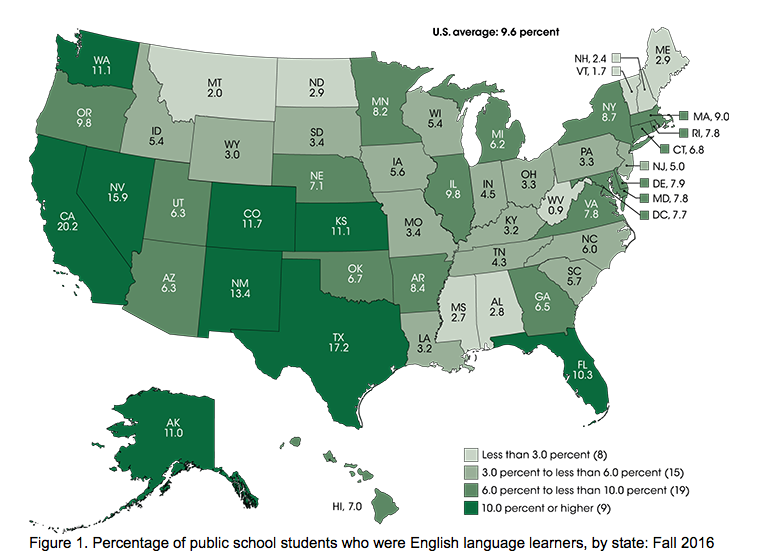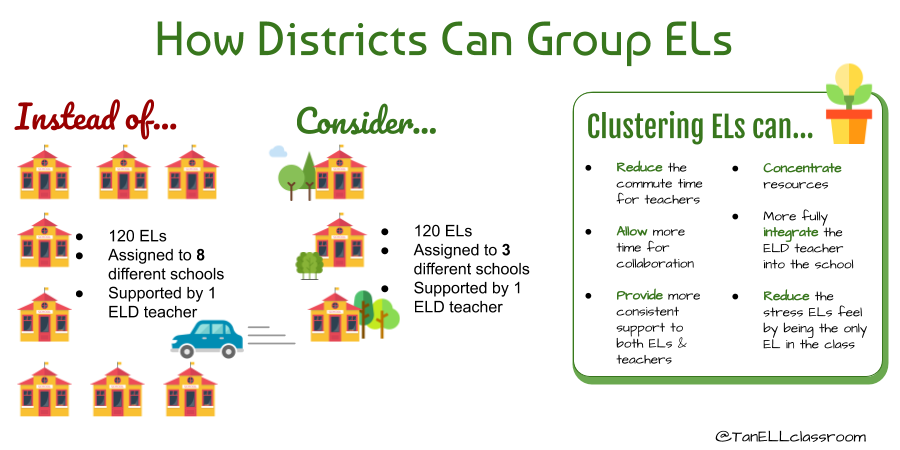How Clustering Our ELs Benefits Everyone
A MiddleWeb Blog
 A couple of years ago, I started using Twitter actively for professional learning. Just about as soon as I could type in the hashtag #ELLs, Tan Huynh’s name popped up. He has long since been a friend and leader I can count on.
A couple of years ago, I started using Twitter actively for professional learning. Just about as soon as I could type in the hashtag #ELLs, Tan Huynh’s name popped up. He has long since been a friend and leader I can count on.
Tan has his own website where he shares fantastic blogs related to his work with ELs. He also cofounded (with friend Dr. Katie Toppel) the #ELLChat_Bookclub. If you are on Twitter, you may have participated in this amazing professional learning opportunity with hundreds of us. Tan also cofounded an online virtual conference called VirtuEL with Carol Salva. It has been outrageously successful for three years now!
It is with great cheer that I announce Tan is joining me on MiddleWeb this year as we write under the Unstoppable EL Teacher logo. I have admired Tan, his work, his writing, and his graphics and know that together we will be an unstoppable team. We aim to be advocates for English learners and educators that serve ELs. And we hope to do you proud. Tan, take it over!
Thanks, Valentina!
This is the first article of a year-long partnership with Valentina Gonzalez. We’ve surveyed our Twitter PLN to ask them what topics they would like us to explore with them. Some of the top themes included:
- Assessment
- Instruction
- SLIFE (Students with Limited or Interrupted Formal Education)
- Learning Support
- Community Engagement
Gloria focused on grouping and that seems a good place to start the discussion, near the beginning of schools in North America:

Limited Resources
We know that in many districts, the ELL population is increasing. The National Center for Education Statistics reported that “The percentage of public school students in the United States who were English language learners (ELLs) was higher in fall 2016 (9.6 percent, or 4.9 million students) than in fall 2000 (8.1 percent, or 3.8 million students)” (2017).
The problem is not that there are more ELs. The difficulty is in how they’re grouped by districts. For a variety of reasons, districts are compelled to place ELs across several schools, often placing only a few ELs at a particular school site. This necessitates support teachers dashing from school to school to provide services. The commute causes several problems for the English language development (ELD) teacher including:
- Reduced planning time
- Less time to work with ELs
- Lost opportunities to co-plan and collaborate
- Decreased time in homeroom and content classes
- A diminished sense of belonging to a school community
All of these issues put a strain on staffing and time – two resources that are already stretched thin in most districts.
Clustering Strategically
Instead of peppering students around a large network of schools, Honigsfeld and Dove (2019) recommend that school districts:
- Strategically cluster students among a smaller collection of schools
- Place a small group of students (6-8) from the same grade in one class
U.S. Department of Education, National Center for Education Statistics, Common Core of Data (CCD), “Local Education Agency Universe Survey,” 2016–17. See Digest of Education Statistics 2018, table 204.20.
As the graphic suggests, moving a single ELD teacher among eight schools increases travel time and decreases instructional support time. Putting more ELs in fewer schools clearly improves services to students and reduces stress (upping effectiveness) for the ELD teacher.
It’s true that with clustering, there will be a slightly higher concentration of ELs in a particular class or at a particular school. But for schools that can use this model, there are numerous benefits, including:
- More opportunities for the content/homeroom teacher to collaborate with the ELD teacher
- ELs receive more contact time with the ELD teacher
- ELs feel emotionally settled as they are not the only EL in the class
- The ELD teacher can be more integrated into a particular school
But the biggest reason for clustering is that it increases the potential for collaboration between the homeroom/content teacher and the ELD teacher. For example, after the school served by Miguel (a homeroom/content teacher) and Halima (an ELD teacher) began clustering, they were able to work together four days a week instead of two. Yes, Miguel has more ELs in his class now, but he also has Halima there to support him more often. If they nurture trust and a positive relationship during this increased contact time, a dynamic collaboration might blossom forth.
Mini-clusters are also an option when grouping ELs at a particular school. Instead of having 10 ELs in the same grade spread across four classrooms, we can cluster them into two different classrooms. This would mean that the ELD teacher can concentrate her time on two classrooms instead of running to four. The ELs benefit because they would also have more contact time with the ELD teacher in the clustering model.
Sweetening the Deal
The hardest part of clustering is convincing the homeroom/content teacher to volunteer to take on more ELs. If the following items are within the administrator’s control, they can offer these conditions to sweeten the deal:
- Asking the ELD teacher to be in class more frequently with the teacher who volunteered
- Limit ELs to a specific number or percentage of the class
- Assign the teacher a subject or grade level they prefer
- Offer a preferred workspace (e.g. the recently renovated classroom)
- Provide more physical resources (e.g. an iPad cart, a flatscreen TV or IWB)
- Reduce the preps or extra duties that the teacher is assigned
- Approve a particular professional learning request or pet project that the teacher is passionate about
The least preferable scenario is to have one particular person teach all of the ELs or have one school be the designated “EL school” in the district. This incorrectly communicates that ELs need to be warehoused and separated from the general population of students.

The administrator doesn’t have to do the convincing all alone. They can have the ELD teacher talk to the homeroom/content teacher about the kind of support that will be offered and share successful experiences of collaboration.
Takeaway
I know that strategic clustering does not happen at the snap of a finger. Student placement is tricky, complicated, and handcuffed by many factors like funding, distance, transportation, staffing, and politics. However, this post is a plea to administrators to seriously consider if strategic clustering of ELs is a viable option for your district. Initiatives like this one require having difficult conversations, yet they are conversations worth having on behalf of the students we serve and the teachers on our team.
Resources
National Center for Education Statistics. (2019). English Language Learners in Public Schools.
Honingsfeld, A., & Dove, M. G. (2019, April 10). Collaboration for English Learners: Foundational Strategies for Successful Integrated Practices [Webinar]. In Corwin Monday Afternoon Webinar Series. (Watch archive here.)






































